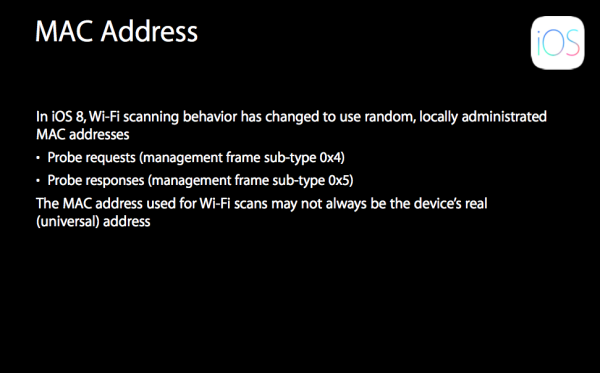Has Apple Killed Location Tracking With iOS 8? Hint: No
Various news outlets are now reporting that Apple has effectively killed location tracking or offline analytics for iPhones with a change in iOS 8 that conceals the phone’s correct MAC address. That’s not exactly true, however. Here’s a slide from a presentation given at WWDC last week that explains the change: Ad networks, WiFi hotspots […]
Various news outlets are now reporting that Apple has effectively killed location tracking or offline analytics for iPhones with a change in iOS 8 that conceals the phone’s correct MAC address. That’s not exactly true, however.
Here’s a slide from a presentation given at WWDC last week that explains the change:
Ad networks, WiFi hotspots and other third parties will no longer be able to grab an iOS 8 iPhone’s real MAC address. This is designed to thwart tracking that seeks to tie an individual to a specific location and potentially match that individual phone with other data for later retargeting.
It may also present a new challenge to ad networks and others that try to profile audiences using location or smartphone movement patterns. And it may present problems for networks seeking to track ad impressions to offline store visits in some cases.
However, this move doesn’t destroy indoor/offline analytics. Companies such as Euclid, RetailNext, iInside, Nomi and others can still see the presence of a device in a store or other venue for analytics purposes. It’s ad networks and data vendors who seek to tie a specific phone to other data and behavior that will probably have trouble.
Apple’s move broadly does two related things. It forces those who want to market to iPhone users to consider ways to get them to opt-in to share location and compels networks and marketers to be more transparent around location tracking. Placed, a location analytics company, uses an opt-in panel to track offline store visits from digital ads. It won’t be affected at all by this.
Data show that users will opt-in to location sharing when they see value in that exchange. Thus where there’s a consumer proposition that is compelling (convenience, rewards, savings) they will likely be willing to share location. Analytics will be available to retailers, brands and others accordingly.
Of course, none of this impacts Android devices. Certain kinds of audience and consumer behavior insights may be extrapolated from Android users. However, as suggested, there will be ways to address the MAC tracking change in iOS 8.
Apple’s MAC scrambling is very consistent with what it did in moving from UDID for mobile-analytics to IDFA (identifier for advertisers). The sky hasn’t fallen.
Postscript: This comment comes from Euclid, one of the indoor analytics companies I mentioned above:
Like Apple, we take privacy very seriously. We only collect anonymous device data and have never collected a device’s real, universal address. Our approach to delivering insights on attribution, shopper funnels, and overall trends, has been to scramble the MAC address prior to collection. We fully support Apple’s decision to add additional layers of consumer protection by randomizing MAC addresses at the device level. Providing additional privacy safeguards at the device level will help address any lingering privacy concerns with Wi-Fi based analytics. We see a major win-win for retailers looking to deploy mobile locations analytics and the consumers they serve.
Opinions expressed in this article are those of the guest author and not necessarily MarTech. Staff authors are listed here.
Related stories
New on MarTech
